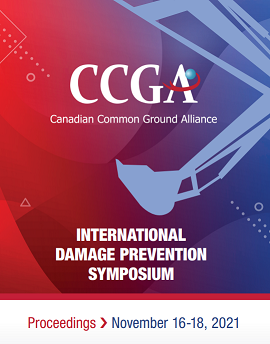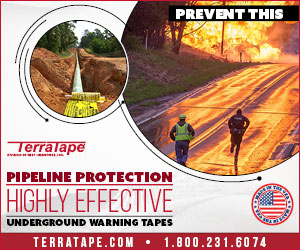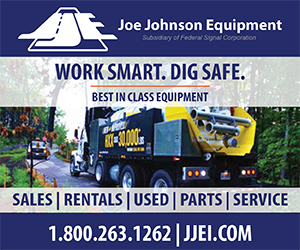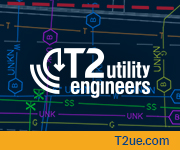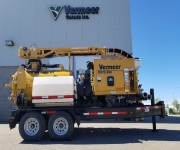 |
||||||||||||||||||
| Archive | Subscribe | Send to a Friend | DigSafeCanada.ca | Dig Safe | ||||||||||||||||||
Top Story
Vous trouverez ci-joint la programmation complète du Symposium international de prévention des dommages de 2021 du CCGA. Si vous avez participé à l’événement en ligne, le CCGA aimerait recevoir vos commentaires. Veuillez remplir le questionnaire à la p. 22 et courez la chance de gagner une carte-cadeau de 100 $! Le prochain Symposium sur la prévention des dommages du CCGA se tiendra en personne et aura lieu du 23 au 27 octobre 2022 à Whistler (C.-B.) au Fairmont Château Whistler. National News
Source: Utility Safety Partners - Mike Sullivan In March 2005, the Common Ground Alliance in the United States secured 811 as the three digit dialing number for Call Before You Dig. It was a monumental and positive shift for the damage prevention process, public safety and the integrity of buried energy and utility assets. “811” became the envy of damage prevention communications across Canada who recognized the benefit of cross-border promotion. With so many transmission pipelines delivering product into the United States, the benefit of a single safety message that could cover two neighbouring countries would have a massive, positive impact. However, in July 2005, following an application by Alberta Health Services to the Canadian Radio-Television Commission (CRTC), 811 was assigned by the CRTC as the three-digit dialing code for Telehealth services. It wasn’t until three years later that the provinces of Quebec, British Columbia and the Yukon Territory adopted it and only in 2015 did all provinces finally do so. In those provinces that did adopt the 3-digit TeleHealth code, there was very little promotion. However, the Canadian Common Ground Alliance (CCGA) believed it could help promote 811 while giving it a dual purpose – dial 811 and “press 1” for TeleHealth and “press 2” for locate. The CCGA’s idea attracted attention. Both the Canadian Energy Pipeline Association (CEPA) and the Canadian Gas Association promoted the path forward and provided assistance to the CCGA securing resources to hire an Ottawa-based telecommunications lawyer that could navigate the CCGA’s application for shared use of 811 through the CRTC. The CCGA submit its application to the CRTC July 15, 2011 and waited what seemed like a very long time for the regulator to render its decision. On March 22, 2012, the CCGA received its answer - Application denied. It was a devastating blow to an organization still in its infancy. We had worked very hard on the submission and promoted the benefits of shared use of 811 across the country. At the time, only a few provinces were using 811, but we were confident we could help promote, proliferate and implement it where it wasn’t yet in use for the benefit of all Canadians. However, there was always a Plan B. Shortly after the CRTC’s announcement, I delivered a presentation to a senior CEPA Steering Committee. They wanted to hear about the CRTC’s decision, its impact and what the CCGA planned to do. I recall assembling my PowerPoint slide deck the night before and making a mock-up of “Plan B” and when I showed it to them, I vividly recall a senior representative from TransCanada PipeLines (now TC Energy) asking me, “Why didn’t we do this in the first place?” Plan B was ClickBeforeYouDig.com. I secured the URL, less than a month after the CRTC rendered its decision, for about $25 and my mock-up showed the senior leadership committee how the website would act as a portal by simply clicking on the province where you were working and commence the locate request process. Everything was switching to the web back then and it just made sense. So, to answer the question from the TransCanada senior leader, the reason we didn’t do this in the first place is because we tend to think linearly. We get wrapped up in an idea because it’s already done. Sometimes, though, being forced to think outside the box is the best thing that can happen to you. At the time in Canada, the percentage of locate requests placed on the web was well below 50% and One Call Centres employed large teams of Agents answering phones during regular business hours interpreting digging locations that were being provided to them by a person on a phone line. The ClickBeforeYouDig call-to-action changed all of that. It opened up the locate request process 24/7 and allowed the person digging to indicate precisely where their digging project was going to take place. Less interpretation improved locate request integrity and reduced damages. Across Canada today, almost 85% of all locate requests are made online. Dare to be different. It usually pays off. Source: Utility Safety Partners - Mike Sullivan En mars 2005, le Common Ground Alliance des États-Unis s’est vu accorder le 811 comme numéro de téléphone à trois chiffres pour le service « Appelez avant de creuser ». Il s’agissait d’un tournant important et d’un changement positif visant à améliorer le processus de prévention des dommages, la sécurité publique et l’intégrité des infrastructures énergétiques souterraines et des infrastructures de services publics. L’obtention du « 811 » a fait l’envie de bien des équipes de communications axées sur la prévention des dommages partout au Canada : ces équipes ont reconnu l’avantage d’avoir une campagne transfrontalière pour la prévention des dommages. Avec autant de pipelines transportant des ressources énergétiques vers les États-Unis, l’avantage d’un seul message de sécurité qui pourrait couvrir deux pays voisins aurait un impact positif énorme. Toutefois, en juillet 2005, et à la suite d’une demande présentée par l’Alberta Health Services au Conseil de la radiodiffusion canadienne (CRTC), le 811 a été désigné par le CRTC comme un numéro de téléphone à trois chiffres pour les services de télésanté. Ce n’est que trois ans plus tard que les provinces du Québec et de la Colombie-Britannique ainsi que les territoires du Yukon ont emboîté le pas, et ce n’est qu’en 2015 que toutes les provinces l’ont finalement adopté. Dans les provinces qui ont adopté le numéro de télésanté à 3 chiffres, il y a eu très peu de promotion du 811. Le Canadian Common Ground Alliance (CCGA) croyait qu’il pourrait aider à promouvoir le 811 en lui donnant une double vocation – composez le 811 et « appuyez sur 1 » pour la télésanté et « appuyez sur 2 » pour une demande de localisation. L’idée du CCGA a attiré l’attention. L’Association canadienne de pipelines d’énergie (CEPA) et l’Association canadienne du gaz ont toutes deux fait la promotion de la voie à suivre et ont fourni les ressources au CCGA afin d’embaucher un avocat d’Ottawa spécialisé dans le domaine des télécommunications pour l’aider à naviguer dans les méandres du processus de demande d’une utilisation partagée du 811 auprès du CRTC. Le CCGA a présenté sa demande au CRTC le 15 juillet 2011 et attend, pendant ce qui a semblé un très long moment, que l’organisme de réglementation rende sa décision. Le 22 mars 2012, le CCGA reçoit la réponse : demande rejetée. Ce fut un coup dévastateur pour une organisation qui en était encore à ses débuts. Nous avions travaillé très fort sur la demande et nous avions fait la promotion des avantages de l’utilisation partagée du 811 dans tout le pays. À l’époque, seules quelques provinces utilisaient le 811, et nous étions convaincus que nous pourrions aider à le promouvoir, à multiplier son utilisation et à le mettre en œuvre là où il n’était pas encore utilisé, et ce, au profit de tous les Canadiens. Mais il y a toujours eu un plan B. Peu après l’annonce du CRTC, j’ai fait une présentation auprès du comité directeur supérieur du CEPA. Il voulait connaître la décision du CRTC, son impact et ce que le CCGA prévoyait de faire. Je me souviens d’avoir assemblé mon PowerPoint la nuit précédente et d’avoir fait une maquette du « Plan B ». Quand je leur ai montré le plan, je me souviens très bien du commentaire d’un représentant de TransCanada PipeLines (maintenant TC Energy) me demandant : « Pourquoi n’avons-nous pas fait cela en premier? » Le plan B était le portail CliquezAvantDeCreuser.com. J’ai obtenu l’URL moins d’un mois après que le CRTC a rendu sa décision. Pour moins de 25 $, avec ma maquette, j’ai montré au comité de la haute direction comment le site Web serait un portail en cliquant simplement sur la province où vous travailliez afin de commencer le processus de demande de localisation. Le transfert massif vers le Web commençait à l’époque et cela avait du sens. Pour répondre à la question du représentant de TransCanada, la raison pour laquelle nous ne l’avions pas fait en premier lieu est que nous avons tendance à penser de façon linéaire : nous avons une idée parce qu’elle existe déjà. Cependant, être forcé de sortir des sentiers battus est parfois la meilleure chose qui peut nous arriver. À l’époque, le pourcentage de demandes de localisation sur le Web au Canada était bien inférieur à 50 % et un centre d’appels employait de grandes équipes d’agents qui répondaient aux appels téléphoniques pendant les heures d’ouverture pour interpréter les sites d’excavation qui leur étaient fournis par téléphone. L’appel à l’action CliquezAvantdeCreuser a changé tout cela : cela a ouvert le processus de demande de localisation 24 heures sur 24, 7 jours sur 7, et a permis à la personne qui excavait d’indiquer précisément l’endroit où son projet d’excavation devait avoir lieu. Moins d’interprétation a permis d’améliorer l’intégrité de la demande de localisation et de réduire les dommages. Aujourd’hui, près de 85 % de toutes les demandes de localisation sont faites en ligne. Osez agir différemment. Généralement, cela s’avère payant.
Regional Partners
Source: CBC News Paul McLauchlin is tired of MLAs knocking on his door before provincial elections, asking him if there are any local construction projects he'd like to announce. "It's not that simple," said McLauchlin, president of the Rural Municipalities Association. "Just running around with a big fake cheque out there." Paul McLauchlin est fatigué d’entendre les gens frapper à sa porte avant les élections provinciales pour savoir s’il a des projets de construction locaux à annoncer. « Ce n’est pas si simple, a déclaré McLauchlin, président de l’Association des municipalités rurales. Cela se résume à courir avec un gros faux chèque. »
|
||||||||||||||||||
|
||||||||||||||||||

